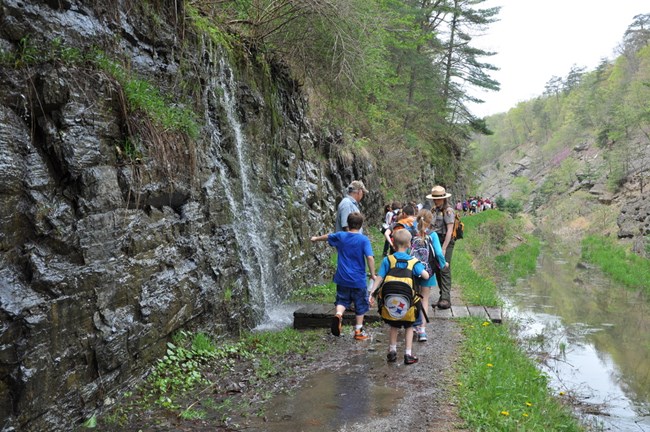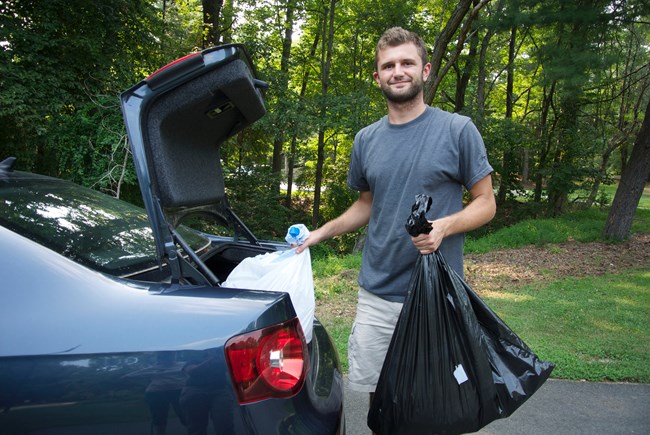
Graphic by Shannon Stanforth
What is the NPS Doing?
There are four core actions that the National Park Service is engaged in with regards to Earth’s changing climate.
1: Using Science to Help Us Manage
Park scientists conduct research to help us understand the effects of climate change on national parks. The National Park Service also collaborates with other scientific agencies and institutions to utilize the best available climate science. This research is then applied to address the specific needs of park managers and park partners as they confront the challenges of climate change.
2: Reducing Our Carbon Footprint
The most effective way to lessen the long-term effects of climate change is to reduce greenhouse gas emissions. The National Park Service aims to be a leader in reducing its carbon footprint through energy efficient practices and integrating climate-friendly practices into administration, planning, and workforce culture.
3: Adapting to an Uncertain Future
Climate change will alter park ecosystems in fundamental ways. The National Park Service must remain flexible amidst this changing landscape and uncertain future. In some cases, bold and immediate actions are necessary, while others require methodical and cautious approaches. As such, many techniques will need to be utilized, evaluated, and refined as new science becomes available and the future of climate change unfolds.
4: Educating about Climate Change
National parks are visible examples of how climate change can affect natural and cultural resources. Park rangers engage visitors about climate change by sharing information concerning the impacts to parks and steps the agency is taking to preserve our heritage.

NPS/4C Photo
Climate Friendly Parks
The National Park Service’s Climate Friendly Parks program is an initiative providing parks with resources and tools to address climate change and ensure the most sustainable operations possible across the agency. There are approximately 140 member parks of the Climate Friendly Parks program. The program’s goals are to:
- Measure park-based greenhouse gas (GHG) emissions.
- Educate staff, partners, stakeholders, and the public about climate change.
- Demonstrate ways individuals and groups can take action to address the issue.
- Assist parks in developing strategies and specific actions to address sustainability challenges, reduce GHG emissions, and anticipate the impacts of climate change on park resources.

NPS Photo
What Can Park Visitors Do?
There are a number of ways that you can contribute to the fight against climate change. From small things like recycling and adjusting your thermostat to buying energy efficient appliances and getting your home’s power from renewable energy, actions that you take every day can make a difference.
Rethink Your Carbon Heavy Commute
- Look into alternative methods of transportation like walking and biking.
- Check out your area’s public transportation options, such as a subway system, public buses, etc.
- If you have to use your car, consider carpooling with others!
- Drive an electric car (if you can afford one).
Share What You Know with Others
- Share what you learn at the park and tell stories about your park experiences.
- Reach out to policymakers to implement more climate action policies.
- Be part of environmental groups in your community.
Support Your Local Ecosystems
- Promote native species by planting native plants and trees in your garden and community. Say, “No!” to foreign plant species.
- Check out a local farmers market or grow a vegetable garden!
Be Mindful of Your Energy Consumption
- Make sure to unplug your chargers and small appliances (i.e,. toaster, coffee maker) from the electrical source when not in use.
- Set your thermostat to its energy saving settings (typically ~75 cool in the summer and ~68 heat in the winter).
- Switch your home to solar energy, either through installing solar panels or purchasing solar energy from a company.
- Use energy-efficient light bulbs, such as CFLs and LEDs.
Decrease Waste
- Pay attention to what you throw away so that you can make more thoughtful purchases.
- Store food correctly so it won’t spoil early.
Visit the National Park Service Climate Change subject website for more information on what you can do to get involved or what you can do at home.

Graphic by Shannon Stanforth
Last updated: August 26, 2021
